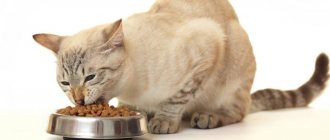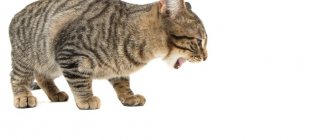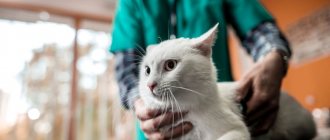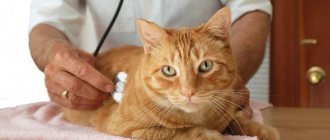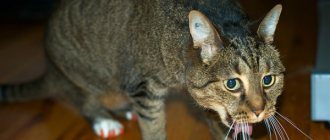A symptom of many diseases in cats is vomiting white foam - a reflex, jerky ejection of the contents of the stomach or intestines through the mouth. Divided by:
- Physiological - is a protective act of the body aimed at getting rid of toxins, indigestible food, less often - it is a symptom of a disease.
- Pathological – is a consequence of the malfunction of various organs and systems, often acting as a symptom of the underlying disease.
Physiological evacuation of food does not pose a threat and usually occurs no more than once a day, without inhibiting the animal’s activity. If your pet has signs of apathy, lethargy, lacks appetite (negative symptoms), diarrhea, jaundice, and fever are observed - this in most cases indicates the development of a pathological process and requires additional measures to be taken.
Causes of foamy vomiting in cats
The causes of white foam vomiting in cats are very diverse - from natural to deadly. If this happens more than once, you should consult an experienced veterinarian. Repeated rejection of food by the stomach indicates problems in some part of the body - from the esophagus and gallbladder to the rectum.
The functioning of the digestive system in cats is the same as in humans. Food enters the stomach and remains there for a couple of hours. After this, processed foods go into the intestines. A special protective mucus is formed in the stomach; if it interacts with air, then white foamy discharge is formed. That's why a cat vomits white foam - it's just a symptom of hunger, this happens in people too. With a single attack of nausea, this option is the norm. But the relapse should not be ignored - it is necessary to take the cat to the doctor.
Physiological reasons
The natural reflex is an important defense mechanism. It helps animals get rid of harmful components - garbage, licked fur, and other foreign objects. Among the natural reasons why a cat vomits white foam are the following:
- Hairballs called trichobezoars often accumulate and form in the stomach. Cats lick themselves more than once a day; their fur becomes a tight mat in the stomach and is not digested. The appearance of a large trichobezoar provokes nausea, and eventually the cat or kitten vomits white foam. This is a defense mechanism that all mammals have. In long-haired individuals, such incidents occur more often; they are recommended to be given special medications to assist in the release of the trichobezoar. For short-haired cats, simply eating grass will be a salvation.
- A cat may vomit white foam if it has eaten too much food in a record short period of time. More often we are talking about dry food: it begins to swell inside, and there is simply not enough space for it. That is why it is worth closely monitoring the volume of portions given to your furry pet. Feedings should be distributed evenly so that the pet does not starve or pounce on food.
- The cat reacts sharply to hunger. If food does not enter the stomach for a long time, it will continue to produce the enzymes necessary for digestion. Gastric juice irritates the mucous membrane of the walls, and as a result, the cat vomits saliva with white foam from hunger.
- Some furry companions are greedy for food and do not control the process of food consumption - they eat a lot and do not feel full. Overeating occurs, and the cat vomits white foam, and undigested food is mixed in with it.
- Curious cats may accidentally swallow a foreign object. If it gets stuck in the throat, then the natural process will be nausea - mucus, foam and other stomach contents will push the foreign body out. And if it moves further into the digestive system, then you can’t do without the help of a doctor - complete or partial intestinal obstruction may occur.
- During pregnancy, cats' hormonal levels change. It is quite logical that the pet is vomiting - the owner should not worry about this. Toxicosis can periodically manifest itself in the last stage of gestation: this occurs due to the pressure of the uterus on the digestive organs and due to the concentration of certain hormones in the blood.
- During the period of sexual heat, a radical hormonal change occurs. The female will become nervous and restless. Disruptions in the gastrointestinal tract may occur, including foamy vomiting.
- Sometimes the animal reacts sharply to certain medications. A white tint and foamy consistency occur when taking antibiotics and some other drugs. If your cat continues to vomit white foam, contact your veterinarian and ask him to prescribe another, more appropriate medication.
- The stress factor should not be excluded. Nausea can be provoked by fear, a change of place of residence, excitement - even just the arrival of noisy guests.
- Carrying out operations. If your pet has recently had surgery under anesthesia, you may experience bouts of nausea. After 24-48 hours, the unpleasant effects of anesthesia should completely disappear.
- If your pet has been vaccinated, then attacks of nausea, fever, apathy and drowsiness are possible. Normally, this condition should not last more than two to three days.
In addition to the presence of natural factors, there are a number of diseases and anomalies. They require maximum attention.
Foamy vomiting as a sign of illness
Unusual accompanying symptoms may indicate diseases of varying severity. The owner of the animal can only make an assumption regarding the disease, and an accurate diagnosis is made exclusively in a veterinary hospital. Here are the most likely diseases of cats when vomiting white foam:
- Infections of viral and bacterial origin. They provoke serious disorders in all body systems and lead to complications. The most dangerous and deadly are distemper, calcivirosis, leptospirosis, etc. In addition to nausea, a sick cat will experience passivity, weakness, reluctance to eat, diarrhea, fever, salivation, and copious discharge from the eyes and nose. These situations can be extremely dangerous - you should quickly get to an experienced doctor for examination.
- Diseases of the digestive system. Almost all gastrointestinal diseases are accompanied by one-time or constant vomiting, as well as diarrhea or constipation. The animal refuses to eat or, on the contrary, eats a lot. But even with a good appetite, your pet can lose weight.
- Infection with helminths. Helminthiasis (infection with worms) has a whole list of symptoms: hair loss, diarrhea/constipation, mood and appetite swings, decreased immunity, the appearance of worms in stool or vomit. This condition is quite dangerous for the pet - without treatment it can die.
Perhaps the most dangerous option is infection with rabies. In this case, foamy saliva comes out of the pet’s mouth, which is sometimes accompanied by nausea. In this case, you should act urgently - take the animal to the veterinarian in a closed carrier.
Any deviation in behavior accompanying foamy vomiting should alert the owner. It is worth observing the cat, and if suspicions increase, take him to the veterinarian.
Pivot table
| Cause | What to do |
| Wool | Regular brushing, malt paste |
| Grass | Observation |
| Feed | Power change |
| Hunger | Feed more often |
| Binge eating | Feed more often and in small portions |
| Foreign body | Treatment in a clinic setting |
| Pregnancy | Diagnostics |
| Estrus | Diagnostics |
| Medicines | Treatment in a clinic setting |
| Stress | Eliminating stress and prescribing sedatives |
| Surgical interventions | Treatment in a clinic setting |
| Viral infections | Treatment in a clinic setting |
| Vaccination | Vomiting is often one-time, no treatment required |
| Pathologies of the digestive system | Treatment in a clinic setting |
| Kidney diseases | Treatment in a clinic setting |
| Oncology | Treatment in a clinic setting |
| Sepsis | Treatment in a clinic setting |
| Helminths | Treatment for helminths |
What is the consistency of foamy vomit?
The appearance of white foamy vomit is considered normal during a long hunger strike or severe stress. In this case, the vomit will not smell unpleasant, and there will be no impurities (except for a small amount of liquid).
If the hairball has accumulated for a long time and stagnated, the vomit may acquire an unpleasant odor. In this case, it is advisable to inspect what the cat burped and make sure there are no bloody or greenish streaks. If they are not there, everything is in order, the body managed itself.
But if you see the presence of impurities or a change in color, feel a sharp unpleasant odor, find blood or strange clots, then it is better to immediately contact a veterinary hospital. A strong, incessant gag reflex will lead to dehydration and exhaustion, so your pet will definitely need your help.
First aid
If your cat is vomiting water and foam, but is not showing any other symptoms, then you can try to help her even before you take her to the doctor. , a daily fasting diet helps a sick animal feel better . Its meaning is to relieve the body and restore some of its functions. The main thing here is to provide the animal with a sufficient amount of water, warm and boiled.
If the animal’s condition has stabilized after 24 hours and vomiting is no longer observed, then you can gradually begin to give food. The optimal food option in this case would be white rice boiled in broth. The cat should be fed at this time as often as possible, but in small portions so that the digestive system has time to cope with the functions assigned to it. After a week, you can begin to switch the cat to a normal diet.
Treatment at home and at the veterinarian
If you notice unusual vomiting in your pet, you should try to help even before you get to the veterinary clinic. It is important to create a comfortable environment at home. Never scold your pet for exhibiting uncontrollable physiological reactions! Carefully monitor the cat, note in a notebook all unusual phenomena and accompanying symptoms - the veterinarian will definitely ask about them.
The bowl should contain clean filtered water at room temperature, but it is better to remove food for a while - especially if you suspect some kind of disease. Protect your pet from the harassment of children and other animals. Prepare a comfortable carrier and a warm blanket for transportation to the clinic (if it’s cold outside).
First aid at home
The very first action is to limit your pet's food intake, unless it is a case of hunger nausea. You should not give food for a day - this will reduce the load on the body. Be sure to carefully examine the vomit to accurately describe everything to the doctor. Ideally, take a photo of them. Observe whether there are accompanying alarming factors: whether the cat behaves restlessly, whether saliva flows, whether complaining sounds are heard, etc.
If your cat is vomiting from hunger, offer him a very small amount of boiled diet food - chicken or beef broth, a little wet food. Start with one tablespoon of food, then gradually, over two days, increase the portion to the usual one. At this time, the interval between feedings should be minimal - up to 3 hours.
During a fasting diet, water should be freely available. You should only use bottled or filtered liquid - tap water will only cause more harm. If the condition stabilizes, then you can give a little boiled rice.
If nausea continues, administer first aid to prevent dehydration. Most likely, the veterinarian will recommend the following over the phone:
- Give the cat activated carbon in a ratio of 1:10, that is, a tablet per ten kilos of weight. Observe all proportions strictly. Dilute the tablet in water and inject it into the mouth from a large syringe, after removing the needle. This will help if nausea occurs due to poisoning.
- If the attacks are short-lived, then you can give the furry patient Regidron solution.
- Dehydration can be prevented with the help of medications Enterosgel and Atoxil - but the dosage should be checked with a veterinarian by phone.
- If the cat is very weak and does not want to take liquid, then you need to inject Ringer's solution.
- If you suspect that the animal has eaten a small object, then you need to provoke a gag reflex. You can prepare a saline solution: to do this, mix one tablespoon of salt in 1 glass of warm water. Give your pet a drink until the urge to feel sick appears.
If the animal’s health does not stabilize within a couple of days, then you should immediately take it to a veterinary clinic.
Going to the veterinary clinic
Treatment for a cat vomiting white foam begins with an examination at a veterinary hospital. Tell the doctor all the information about your pet and its condition, when you began to notice such phenomena, and whether there are any chronic diseases. To make a correct diagnosis, you will need a thorough examination of the animal, laboratory tests, ultrasound of the abdominal cavity and kidneys. Based on the results, the veterinarian will establish a treatment regimen: it usually includes drug therapy and the parallel elimination and prevention of dehydration.
It is impossible to say in advance what medications the veterinarian will prescribe - it all depends on the primary disease. Infectious diseases will require a course of antiviral and antibiotics along with immunostimulating therapy. In case of poisoning, it is necessary to administer an antidote and detoxify the body. If there are problems in the gastrointestinal tract, the problematic organ is identified and treated.
Don't forget about the special diet. Food should be semi-liquid. It is best to feed small and frequent meals. If you give meat, it must first be boiled and chopped. After everything has stabilized, you can gradually switch to normal nutrition.
Carrying out prevention
Prevention of sudden attacks of the gag reflex is carried out with the help of:
- regular anti-worm therapy. For cats walking outside every 3 months;
- annual vaccinations, preventive examinations at a veterinary clinic for timely detection of hidden diseases;
- proper nutrition. Balanced ready-made food in sufficient quantities will help avoid pathological conditions;
- pet care. Brushing will prevent the accumulation of hairballs in the stomach;
- maintaining hygiene in the home. A clean room and no small objects that the cat could swallow.
Combing
White foam along with the contents of the stomach can have both physiological and pathological origin. The appearance of accompanying clinical signs requires seeking professional help and undergoing a full diagnostic examination. Timely treatment will avoid complications and save the life of your pet.
Preventing the gag reflex
Preventative measures to prevent the occurrence of an unpleasant gag reflex in pets include:
- Annual vaccination, anthelmintic therapy every 3 months.
- Regular visits to the veterinarian for preventive purposes.
- Sufficient, high-quality and balanced feeding of the pet, for dessert - a special herb for cleansing and healing the cat’s body.
- Systematic care of cat hair - bathing, combing, cutting if necessary.
- Cleanliness and hygiene in the house, small items should not be in the free access of the animal.
A responsible and competent owner will always come to the aid of a sick pet, because people are responsible for those they have tamed. Knowing a lot about white foam and vomiting, its causes and consequences, you can start treatment on time, react correctly to what happened and prevent complications. Then your pet will be happy again and give a smile to others!
IMPORTANT! VETERINARIAN CONSULTATION REQUIRED. INFORMATION FOR INFORMATION ONLY. Administration Share with friends Article rating (1 ratings, average: 5.00 out of 5)
Vomits white foam
Why does a cat vomit white foam?
23298Administration
A pet's illness always brings owners a lot of worries and troubles. A cheerful and mischievous pet suddenly becomes sad and lethargic - this is familiar to many. What if a cat vomits white foam? From a medical point of view, the gag reflex is considered as a natural physiological process that helps the animal empty its stomach.
There may be several reasons that provoke white vomiting. If white foamy vomiting in a cat is repeated many times, this may indicate some kind of disease and cannot be avoided without the help of a veterinarian.





